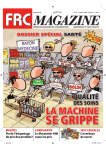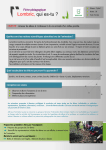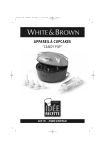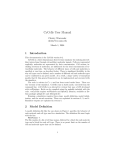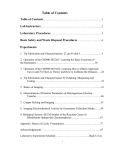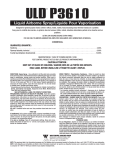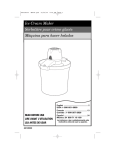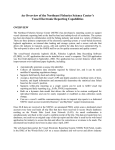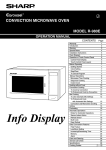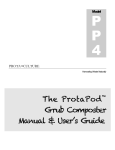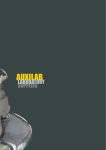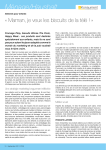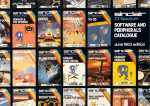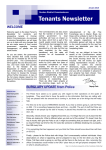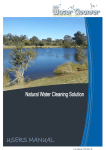Download Fake Animal Scat - National Geographic Events
Transcript
Fake Animal Scat What you do: Hand out the Animal Scat Identification Charts. Explain to the students that scat is the name for poo that is found in the wild. This chart shows the scat from different wild animals. The first column of animals are herbivores, which means that they only eat plants. The middle column shows carnivores, or meat-eating animals. The last column lists omnivores, or animals that eat a mixture of plants and animals. Ask the students if they notice any similarities among the herbivores. (The scat is more round and it is small.) How about among the carnivores? (The scat is pointed at one or both ends. It is long and thin.) And the omnivores? (This scat is variable. However, it is usually oblong rather than round.) Tell the students they will choose one animal scat from each of the three categories to model. Distribute the clay or oatmeal poo mixture, sheets of paper, and pencils. Once completed, a scat model is placed on a sheet of paper and labeled with the animal’s name and whether it is an herbivore, carnivore or omnivore. Recipe for oatmeal poo mixture Measuring cup Teaspoon Oatmeal (not instant) Water Cocoa powder 1. Place 1/2 cup oatmeal on plate; grind oatmeal with your fingers to make it less chunky. 2. Add 2 teaspoons cocoa; mix with fingers. 3. Add water little by little until oatmeal mixture can be molded. in the Classroom What you need (per student) • Animal Scat Identification Chart • 3 sheets of paper • Pen or pencil • 1/2 cup of clay or oatmeal poo mixture Animal Scat Identification Chart in the Classroom Herbivore Carnivore Omnivore Rabbit Fox Raccoon Round, slightly squashed pellets of finely chewed plant material. Dark brown, tan or black depending on food. Note tapered ends and hair in scat. Fox scat will almost always have these two features, and it may be thicker or thinner depending on food, animal, and level of decomposition. Note blunt ends and uniform thickness, like a Tootsie Roll. Scat will contain berries, seeds, corn and perhaps crayfish parts. Deer Coyote Opossum Vary in size but are generally squashed spheres with a slight taper. There will generally be a small pile. Entirely vegetative and quite uniform in consistency. Very similar to fox, but larger. A large fox and a small coyote may have identical scat. Uneven and variable due to changing food sources. May contain hair or berries. Often in small segments. Not commonly found. Porcupine Mountain Lion (Puma, Cougar) Rat Somewhat variable in shape, but usually oblong. Contain a great deal of wood pulp. Individual scat may be connected by thin strands. Chords with uniform diameter. May contain fur or feathers. Scats rarely seen since cats cover it up. Dark brown or black, even consistency. Small, oval pellets. Blood Colors This can be done as a demonstration or as an activity in small groups. in the Classroom What you do: When you think of blood what color do you imagine? People mostly think of red because that is the color of our blood and the color of blood for many animals. However, blood also comes in several colors besides red. Today we will make fake blood that represents each of the different blood colors for animals. 1. Into the bowl, place 1/4 cup of corn syrup and 2 spoonfuls of water. Stir well What you need (per group) • 1 teaspoon cornstarch • Red and blue food coloring • Droppers (if you don’t have the food coloring that comes in dropper bottles) • 1 teaspoon powdered cocoa • 2 spoonfuls water • 1/4 cup clear corn syrup (type used for cooking, not for pancakes) • Bowl • Spoon • Measuring cup • 3 small paper cups (or other small containers) • Marker or pen 2. Use your spoon to divide your mixture into the 3 cups. Let’s look at one of the cups.What color would you say this blood would be? Some animals actually have clear or whitish blood. Can anyone think of an animal that may have clear blood? Most insects have clear blood. That is because blood color comes from tiny bits of metal in blood. However, insects do not have any metal in their blood. Can anyone name an insect? blood 3. On one of your cups, write Insect blood. 4. Now… To one of the unlabelled cups, add 1/2 teaspoon of cornstarch. Stir well. 5. Add 4 drops of red food coloring. Stir. What color did you make? It is a light red. 6. To make it a deeper red, add 2 pinches of powdered cocoa. Stir very well. What animals have red blood? Animals with backbones, or vertebrates, have red blood. The “red” in red blood cells comes from a pigment called hemoglobin. “Hemo” comes a Greek word for blood. The pigment has iron molecules in it. Oxygen combining with the iron in hemoglobin makes the blood rust to turn it a red color. 7. Use your pen to label the red blood cup, Vertebrate blood. 8. In the last cup add a pinch of cornstarch and stir. 9. Add 4 drops of blue food coloring. Did anyone know that some animals have blue blood, especially when it is exposed to oxygen? Can you guess what animals might have blue blood? Lobsters, crabs, pillbugs, shrimp, octopus, crayfish, scallops, barnacles, snails, small worms (except earthworms), clams, squid, slugs, mussels, horseshoe crabs, most spiders. None of these animals have backbones. Some of these animals are Mollusks, like the snails. Some are Annelids, like the small worms. Some are Arachnids, like the spiders. Some are Crustaceans, like the crabs. Copper metal gives some animals stylish blue blood. This blue blood chemical is called hemocyanin. blood 10. Label your blue blood cup with one of the blue-blooded groups: Arachnids, Annelids, Mollusks, or Crustaceans. Now who can name an animal with clear blood? With red blood? With blue blood? What is the part in blood that determines the color? Yes, it is whether or not there is metal in the blood and the type of metal. What you need (per student) • Handout of possible animals • Candy Animal Poo worksheets in the Classroom • Handout of different animal scat pictures Candy Animal Poo poo This workshop can be done as a class or it can be done at a table set up for the general public. What you do: • Pen or pencil • Several of each of the following candies: Tootsie Rolls, chocolate sprinkles, chocolatecovered macaroons, Raisinettes, brown M&M’s, licorice jelly beans, Baby Ruth or O’Henry bars, mini-kisses (or regular if you can’t find the minis) • Paper towels Scat is the name for animal poo that is found in the wild. The way the scat looks can tell scientists a lot about what animals are in the area, how many and what the animals eat. Sometimes it is difficult to see the animals directly, so the poo that they leave behind is the next best thing. People who study wild animal poo are called scatologists. The scat from a certain animal, say a dog, will have a certain shape and texture. Today we will be studying the shapes of different animal waste and matching that shape to something you may enjoy in your everyday life, candy. dookie Distribute the handouts These are the animals that we will explore today and the pictures of their scat. How would you describe the deer scat? The raccoon scat? How do the raccoon and deer scat differ? Is there a type of candy that the raccoon scat might resemble? Hand out the worksheets This is a list of the different candies that we will work with today. Your job as scatologists is to match the candy with the animal that has a similar poo shape. You should pay careful attention to the animal scat pictures before choosing which candy for each animal. You may want to place a sample of the candy scat on the picture of the animal before you fill in your final answers on the worksheet. I will now hand out the various candy samples. Please do not eat the samples. Distribute samples to each student. Give them time to complete the activity. When they are through, regain the group’s attention. caca Which animal’s scat did you think looked like chocolate sprinkles? Take answers. If the students vary in their answers, have each student explain why they chose that candy. If the explanation is valid, the choice is fine. There are really no “correct” answers. I thought the mouse scat looked like chocolate sprinkles. Continue through the rest of the worksheet You have been observant scatologists today. Now you can go ahead and eat your candy scat models. Candy Animal Poo Candy (Scat) Chocolate sprinkles turd Animal Chocolate macaroons M&M’s Raisinettes Jelly beans (licorice) poop Baby Ruth/O’Henry Hershey’s Kisses Tootsie Rolls in the Classroom Suggested Answers for Candy Animal Poo Candy (Scat) Chocolate sprinkles turd Animal Mouse Chocolate macaroons Beaver M&M’s Rabbit Raisinettes Deer Jelly beans (licorice) Rat poop Baby Ruth/O’Henry Human Hershey’s Kisses Elk Tootsie Rolls Raccoon in the Classroom Creepy Crawly Collection This is bigger than an insect collection. Insects only have six legs. In this collection, you can have 8-legged critters, or arachnids, such as spiders. You can also have manylegged crawlies, called arthropods, such as millipedes. Everyone in your class can bring in bugs to add to the collection. How fun! What you do: 1. Collect a bunch of bugs at home. And you don’t even have to kill them. You can find dead creepy crawlies in light fixtures, lamps and along window sills. 2. Line the box or bag with a paper towel. Place your bugs into the container. Bring all of the bugs to school even if you have more than one of some kinds, since you can give your extras to someone else. 3. Place a small ball of clay in the center of a cardboard square. 4. Remove a bug from the container. in the Classroom What you need (per student) • Dead creepy crawlies (from home) • Bag or box (from home) • Paper towel (from home) • Clay • Paperclips • Small squares of tag board or cardboard • Pen or marker • Books or pictures for bug identification 5. Bend a paperclip to make part of it straight. 6. Very carefully spear the bug underneath with the paperclip. Try not to push the metal all the way through the bug; just push the paperclip in enough to hold the bug. 7. Stick the curved end of the paperclip into the clay. 8. Use books, pictures or a bug expert to find the type of bug that you have. 9. Use a pen or marker to label the cardboard with the name of the bug. 10. If you have more, mount a different bug into a new cardboard square with clay and a paperclip. Don’t forget to label the cardboard with the name of the bug. 11. Admire your creepy crawly collection. What you need: in the Classroom Fish Printing Workshop Preparation • 2-4 different types of fish (small, flat flounder or scup work well), fresh or frozen (rubber fish can be used). Depending upon the size of the group, you will need at least one fish for every 5 participants. • Ink or paint (water-soluble block printing ink, acrylic paint, etc.) • Paper (rubbing paper, rice paper, construction paper, etc.) OR white T-shirts OR T-shirt material cut into squares • Small paintbrush for each fish printing station The surface of the fish must • Newspapers be thoroughly cleaned • Paper towels because mucus and dirt will obscure the detail. Wash • Pens or making pens the fish in soap (e.g. dish detergent) and water until the mucus is gone. If fish are to be used right away, wash and pat dry. For use later, wash, dry, and freeze fish in plastic bags. Defrost approximately two hours before use. The day of the workshop, cover the fish printing tables with newspaper. Place the paint brushes and paints at each station. Designate a drying station for the prints. Set up a paper table with pens or markers for signing and labeling the prints. If possible, it is best if the participants do not sit at the print stations, but rather at separate tables or on the floor until the printing begins. Workshop Introduction With the participants seated on the floor or at tables away from the print area, as a display, hold up one of the fish that will be used in the printing. All fish are vertebrates, which means that they have a backbone. The external anatomy of a fish is very different from our own, because they move and live in water, and we live on land. For example, fish have “noses” (called nares) that don't look anything like our own, yet their purpose is to smell chemicals in the water. What can we say about how a fish moves by looking at its body shape or form? What body parts of the fish are similar to humans? What body parts are different? Fish Printing The Japanese art of fish printing is called Gyotaku (Gyo means fish, Taku means print). The Chinese began making fish prints over 600 years ago as a means of recording fish catches. It was developed into an art form by the Japanese. Demonstrate while you go over the steps of fish printing. 1. Choose which fish you would like to print. 2. With a small brush gently paint one side of the fish with ink/paint. Make sure all areas are covered including the fins. Use very little ink. Brush from the head of the fish to the tail. Most people use too much ink the first time, so be careful. After removing excess ink from your brush, brush gently from the tail toward the head. This will catch the ink along the edge of the scales and spines, producing sharper detail. 3. Take paper and gently but firmly press down on the fish. Rub evenly over all areas, especially the head and fins. Be careful to not move the paper while pressing. 4. Carefully lift the paper up, making sure the fish does not move and smear the print. 5. Wipe the excess ink/paint off with a paper towel. Make sure to wipe from the head to the tail. 6. Don’t forget to sign your print and label it with the name of the fish. 7. Place your Gyotaku on the drying area. If you have time, try another print. If you choose to make Gyotaku T-shirts, the students can make another print on a clean section of the shirt. Can You Jump as High as a Flea? Fleas are blood-sucking insects. To get to their dinner, they often have to jump. Fleas are amazingly skilled at jumping. They are very tiny, but they can jump 150 times their height. To find out how high that would be for you, try the activity. What you do: 1. Measure your height in inches. If you know your height in feet, then multiply that number by 12 to get inches. 2. A flea can jump about 150 times its height. Calculate how many inches that would be for you to jump as high as a flea. To do this, multiply your height by 150. 3. To see how long that jump would have to be, use the measuring tape to mark the length on the ground. Unless you have a very large room to work in, you may need to go outside to do this. 4. It is probably easy to see you can’t jump that far in one leap. Find out how many leaps it takes you to make one flea jump. Aren’t fleas incredible? If they could only learn how to dribble a basketball. in the Classroom What you need (per group) • Measuring tape • Calculator • Paper • Pencil A Meal of Mealworms Depending upon which recipe you choose, the ingredients will vary. in the Classroom Obtaining and preparing mealworms You can purchase mealworms from pet stores, bait shops or online. If your mealworms are packed in bran or cornmeal, there is no need to purge. However, if they are packed in newspaper or paper, remove the paper completely and add cornmeal. Allow the mealworms to eat the cornmeal for 24 hours or longer. yum What you need (per class): • Colander • Water About 1-1.5 hours before the activity, put the mealworms in a colander and rinse well with tap water. Place onto a paper towel and pat dry. Remove any dead mealworms. Dead worms will be darker in color. Put the cleaned mealworms into a plastic bag and freeze for 15 minutes. • Paper towels Roasting the Mealworms If you are making the Mealworm Crispies, take the cleaned insects from the freezer and place on a baking sheet covered with paper towels. Bake at 200°F for 1 hour. • Measuring cup What you do: • Cornmeal • Freezer • Plastic bag • Measuring spoons yum 1. Ask the students “What animals eat insects?” Take answers. If none of the students mention humans, ask “What about humans?” 2. Ask the class if anyone has ever eaten insects either by accident or on purpose. 3. Tell the students that insects are eaten by people all over the world except for North America and Europe. And in North America, the Native Americans and settlers did eat insects. In fact, there are over 1,462 recoded species of edible insects. Insects are high in protein and low in fat. So they are quite healthy. The only reason people don’t think of insects as a food source is because of how they were raised. For example, if they were born in Thailand, they may eat silkworm pupae, or they would eat grasshoppers if they were born in Japan or China or Mexico. yum 4. Tell the students that today they will try eating insects. They will try mealworms. Show the students the frozen or roasted mealworms. Tell the class that mealworms are the pupa or larval stage of a grain-eating beetle. 5. Remove several mealworms for the students to observe. 6. Explain how the mealworms were obtained and prepared. 7. Depending upon which recipe you chose, proceed with the cooking. Mealworm Crispies 1/4 cup margarine Stove or hotplate 4 cups mini marshmallows Saucepan 3 cups crispy cereal Spoon 3 cups roasted mealworms 9x13 greased pan In a saucepan, melt margarine and marshmallows. Remove from heat and add crispy cereal and roasted mealworms. Stir. Spread into a 9x13 greased pan. Cool Spicy Mealworm Crunchies 2 tsp cayenne 6 cups party mix (optional) 1 tsp black pepper Stove or hot plate 1 cup mealworms Saucepan 6 Tbsp butter or margarine Spoon Place everything but the party mix into a saucepan. Stir continuously until the mealworms are golden brown. Drain and serve. Or if desired, add the mealworm mixture to party mix and serve. yum 8. After the students have eaten the mealworms, ask “How did they taste?” “Would you ever eat mealworms again?” “Would you ever consider eating other bugs?” 9. Tell the students the proper word for insect eating is Entomophagy. “Entomo-” means insect and “phag” means to eat. Observing Worms What you do: 1. Obtain a worm and place it in the container with soil. in the Classroom 2. Compare your worm to someone else’s worm. How is your worm different? Could you tell them apart? 3. Draw your worm. Which part is the head? Which part is the rear? Label your drawing. 4. How can you tell the top of your worm from the bottom? squirm 5. Find the band circling your worm’s body near its front end. This is called the clitellum. Make sure your drawing has a clitellum. Label the clitellum on your drawing. 6. Does your worm look smooth? 7. What does your worm feel like? 8. What does your worm smell like? 9. How does your worm move? 10. Does your worm have a mouth? 11. Find the blood vessel the runs the full length of the worm. What color is the blood vessel? 12. Does your worm prefer the dark or the light? Design an experiment to test this question. Teacher Answer Sheet for Observing Worms 2. Answers will vary. 3. The head part of a worm is more pointed, and the rear is flattened. A student may also notice that the worm moves head first. 4. The top is darker than the bottom. A student may also notice that the worm keeps the bottom side down in the soil. in the Classroom What you need (per student) • Earthworm 5. The clitellum should be labeled on the worm drawing. • Plastic container or lid filled with soil 6. A worm has bumps or rides, so it does not look smooth. • Pencil 7–9. Answers will vary. 10. A worm has a mouth but it may be difficult for the students to see. 11. The blood vessel is purple. 12. Answers will vary. One-Meter Hike There are many creatures right under your feet – an entire world in the grass and the garden. In this activity, you will take a one-meter hike. For you this may not seem very long, but imagine you are a small creature like an ant. This would be a very long and exciting adventure. What you do: 1. Find a patch of grass or garden. in the Classroom What you need (per group) • Meter stick 2. Place your meter stick on the ground. This is the length of your hike. • Magnifying glass (optional) 3. Pretend you are a very small creature, such as an ant. Place your eyes very close to the ground and begin your hike. If you have a magnifying glass, use it to observe closely during your hike. • Patch of grassy area or garden area 4. Draw what your world would look like if you were the size of an ant. 5. Draw any insects you see. Draw interesting objects, such as rocks or shells or bird poo. Draw any large animals that may cross your path, such as birds or worms. • Paper • Pencil What you need (per group) in the Classroom • Owl pellets (you can order these through scientific supply houses) • Water • Toothpicks Owl Pellets vomit • Bone identification chart Owls eat small rodents, reptiles and birds. They swallow their prey whole. An owl’s stomach acids aren’t strong enough to digest bones or hair. Owls vomit up the indigestible stuff about 24 hours after they eat. If you want to look for owl pellets, look under the tree where an owl roosts during the day. What you do: 1. Inspect the pellet. Note the size and any features that might help you figure out where it came from. bones 2. Soak the pellet in water. 3. Very gently, pull apart your pellet. 4. Use the toothpicks to separate the bones from the fur and feathers. 5. Roll the last bits of fur between your fingers to find tiny bones or teeth that may have been overlooked. 6. Try to lay out or reconstruct the skeletons of the animals you found. How many animals did you find in each pellet? Can you identify the animals? Bone Identification Chart in the Classroom skull jaw metacarpal (“finger”) shoulder blade radius humerus rib vertebra ulna femur (thigh) hip bone fibula tail vertebra Please feel free to photocopy this for your students. tibia metatarsal (toe) Teacher Instructions for “Which Sea Creature Am I?” What you do: in the Classroom After handing out the “Which Creature Am I?” descriptions, give the students some time to complete their drawings. When they have finished, have several students share their drawings with the class. Point out any inaccuracies. If any student actually drew a sea star, show it to the class and slowly go over the description to show that it fits. What you need Share with the class a picture of a sea star. • Books or pictures of sea animals, including a sea star • Pens or crayons • Paper • Handouts of the sea star Instruct each student to choose a sea animal, such description as a hagfish, sea anemone, tubeworm, octopus, eel, slug, snail, shark. Have the students look up pictures of the animals in books or have pictures available for the students. Give each student time to write a description of the animal chosen. Students can then swap descriptions with partners or they can volunteer to read their descriptions to the class to see if others can make drawings from their description. Which Sea Creature Am I? Draw an animal from the following description. It has no head or brain. Most animals of this kind have five in the Classroom or more arms, but no fingers. Attached to the bottom of each arm are feet, but no legs. The feet are usually in pairs and one animal can have over 1000 feet. In the center of the feet is this animal’s toothless mouth. This animal is often covered with bumps or little spines. It comes in various colors, such as purple, red and yellow. in the Classroom Snail Trails Snails slime along from the snow line to beneath the sea. Snails like damp places, but they can survive without water by hiding out inside of their shells. They actually plug up their shell opening to seal themselves off. What you need (per group) • Snail • Clear rigid plastic What you do: 1. Find a snail. Morning or evening is usually the best time to go snail hunting. Snails really like gardens. The best time of year is during the spring or summer. 2. Lift the snail gently by the shell. Place it in a box or jar to bring to school. Feed your snail lettuce. 3. Remove your snail from the container. Place the snail on a sheet of clear plastic. slimy 4. Hold up the plastic to observe the snail as it crawls. If the snail won’t move, place some lettuce at one end of the plastic. 5. Place objects on the plastic in the path of the snail. Watch the snail glide across the objects. 6. Observe from above and below the snail. 7. If you feel really brave, place the snail on your hand. Feel the creature slime across your palm. 8. Return the animal to a moist area. Away from your garden would be the best bet. • Pebbles, marbles or other small items • Lettuce Squid Dissection Workshop In order to preserve them overnight, the squid can be frozen and thawed the next morning. Frozen squid can easily be obtained at Chinese markets and from local supermarkets, often in the frozen food section. If obtaining them from the local supermarket and/or if the package is marked “Calamari” make sure that they are whole squid and not just “tubes and tentacles.” On the day of the workshop, organize the dissection tools for each group. Set up the cooking corner. Crack the eggs into a bowl and stir. Pour the seasoned flour mixture into the plate. in the Classroom For the Workshop you need (for a group of 2 or 3) • 2 paper plates • 1 pair of clean scissors Workshop: Introduction Organize the students into groups of 2 or 3. • 4 toothpicks • 1 hand lens (optional) • 1 scrap of paper • Squid diagrams Who has ever heard of a squid? What do you know about squid? Take answers from the students. • 1 squid Hand out the squid diagrams. Everybody needs clean hands for this because we are going to eat the squid at the end of the class! As the students wash their hands, place the dissecting materials on the tables. External anatomy: Place the squid right side up on the plate. You should have the mid-ventral ridge facing you with the tentacles at the top. 1. Arms and tentacles. Are they the same size? Do they look alike? How many arms are there? How many tentacles are there? Take answers for each of the questions. 2. Look at the suckers with the hand lens. Notice all the small teeth in a ring around the suckers. They are used to hold the prey. Squid capture their prey with the tentacles and bring it to the arms to be held until the prey stops struggling. 3. Look inside the circle of the arms and tentacles. The small black dot is the beak. Use a toothpick to push the tissue back from around it. Can you see the 2 halves? It looks like a parrot beak, and is very powerful. It is used to tear pieces from the prey. 4. The eyes are much like our own, but the lens is shaped like a football. What is the shape of our eyes? Squid can tell the difference between light and dark, blue and yellow. 5. The main part of the body containing all the organs is called the mantle. It is the pocket of skin that covers the body. The mantle is covered in pigment cells called chromatophores. Squids can change color rapidly and they use this to camouflage themselves, to attract mates, and to communicate with each other. 6. The squid has two fins on the mantle near the pointed end of its body. The fins are used as stabilizers and to propel the squid. 7. The siphon is a short tube with one opening on the head between the eyes and the other end just under the mantle collar. The siphon propels the squid through the water in the opposite direction to which the siphon is pointing, much like jet propulsion. To use this jet propulsion, the squid takes in water through the large opening and then closes off the opening. The only way the water can escape is through the smaller siphon. The mantle muscles contract and the water comes out with enough force to propel the squid through the water at about 20 miles per hour! Internal Anatomy: Make sure your squid is placed back on the plate with the mid-ventral ridge side up. We are now going to look inside. 1. Cut open the mantle of the squid directly down the midline starting at the mantle opening near the siphon and continuing down the length of the body to the tip. Spread back the sides of the mantle to expose the internal organs. Be sure to lift up with the scissors when cutting so as not to cut into the internal organs of the squid. 3. The yellowish liver is a long organ in the center of the body that runs up toward the head. The liver provides digestive enzymes. 4. The ink sac is located on the rectum and looks much like a small silver fish or thin black line depending on how full the sac is. Very carefully, snip the sac at both ends and place it on the plate next to your squid. After the ink sack is removed, dip the tip of a toothpick into the ink sac and try writing your name on the scrap paper. The ink is the pigment which artists call sepia ink. Squids squirt ink from the sac to protect themselves from attackers. 5. The gills are 2 white, feathery structures found within the mantle cavity. What is the purpose of the gills? 6. At the base of each gill is a branchial heart (also called the gill heart) which pumps blood from the body up to the gills to be oxygenated. Each of these hearts is quite small and slightly yellowish in color. Squid actually have 3 hearts! The third heart is larger and located between the two branchial hearts. This is called the systemic heart and pumps oxygenated blood from the gills to the rest of the body. 7. The squid is supported by a structure called a pen. This structure is the remnant shell. To locate the pen, lift up the head and place it down over the top of the organs of the body. Underneath where the head was lying on the plate, you will now notice a pointed area right along the midline of the body. This is the tip of the pen. Grasp this tip and pull until the pen comes free of the mantle. The pen is as long as the mantle and is shaped like a transparent feather. Now to prepare the squid for eating: 1. Remove the fins by grasping the mantle in one hand and the fins in the other and pulling to remove the fins. 2. The arms and tentacles are eaten. Cut them off the mouth and eye area, keeping all of the tentacle and arms joined in one large ring. Place the arms and tentacles onto your clean plate. 3. Grasp the squid’s head in one hand and pull it down over the body toward the pointed end. This should pull most of the internal organs off in one piece. Remove the gills separately. 4. Now turn the mantle over and peel off all the colored skin. You should be left with cleaned white mantle. Place the cleaned mantle onto your plate with the arms and tentacles. Cut the mantle into strips, starting from the bottom of the mantle to the tip. 5. Discard all the internal organs. 6. Take the cleaned squid on the clean paper plate over to “cooking corner.” Cooking Corner 1. Coat the squid strips and the tentacles with egg, and then roll them in the seasoned flour mix. 2. Preheat the pan with a tablespoon of oil 3. Add the seasoned squid and stir for about 1 minute or until the meat begins to curl 4. Remove from the oil and place onto paper towels For the Cooking Corner you need • Electric wok or hotplate and frying pan • Spatula • Knife • 3 eggs • 5 tablespoons olive oil • 3 cups seasoned flour (such as Dixie Fry) or mix 1 cup of flour + 2 cups breadcrumbs + 1 teaspoon pepper • 1 lemon or cocktail sauce (optional) • Bowl 5. Garnish with lemon or cocktail sauce if desired • Plate You may need to add more oil depending upon the amount of squid to be cooked. • Paper towels Squid Diagram in the Classroom Match Up Your New Animal GROSSOLOGY Terms... in the Classroom ? Terms Animal GROSSOLOGY Ruminant Pellet Proboscis Pheromones Mucus ? ? Definitions fly feeding tube an illness caused by certain ticks scent glad communication chemicals scientific word for poo farm animal waste (poo) the science of creatures gross and disgusting ?? ? Rumen Lyme Disease Intestine Feces Scarab Amphibian Manure the gut tube of animals cud munchers, such as cows, goats, camel, deer, antelope and sheep sticky liquid that slimes the inside and outside of many living things the first section of a ruminant’s stomach cold-blooded, slimy skinned animal, like a frog the waste ball spewed out by some birds a type of dung beetle Teacher answer sheet for Animal GROSSOLOGY Matching in the Classroom ? Terms Animal GROSSOLOGY Ruminant Pellet Proboscis Pheromones Mucus ? ? Definitions fly feeding tube an illness caused by certain ticks scent glad communication chemicals scientific word for poo farm animal waste (poo) the science of creatures gross and disgusting ?? ? Rumen Lyme Disease Intestine Feces Scarab Amphibian Manure the gut tube of animals cud munchers, such as cows, goats, camel, deer, antelope and sheep sticky liquid that slimes the inside and outside of many living things the first section of a ruminant’s stomach cold-blooded, slimy skinned animal, like a frog the waste ball spewed out by some birds a type of dung beetle



























